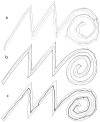Cerebellar TMS in treatment of a patient with cerebellar ataxia: evidence from clinical, biomechanics and neurophysiological assessments
- PMID: 23625327
- PMCID: PMC3951770
- DOI: 10.1007/s12311-013-0485-8
Cerebellar TMS in treatment of a patient with cerebellar ataxia: evidence from clinical, biomechanics and neurophysiological assessments
Abstract
We describe a patient with a probable diagnosis of idiopathic late-onset cerebellar atrophy who shows improvement of limb coordination, speech, and gait following 21 days of transcranial magnetic stimulation (TMS) applied to scalp regions presumably corresponding to the cerebellum. This case study provides, for the first time, a quantitative assessment of gait improvement in response to TMS therapy in ataxia, as well as neurophysiological evidence in support of modification of cerebellar-cortical interaction that may underlie some of the improvements.
Figures



Similar articles
-
Repetitive transcranial magnetic stimulation of the cerebellum improves ataxia and cerebello-fronto plasticity in multiple system atrophy: a randomized, double-blind, sham-controlled and TMS-EEG study.Aging (Albany NY). 2020 Oct 21;12(20):20611-20622. doi: 10.18632/aging.103946. Epub 2020 Oct 21. Aging (Albany NY). 2020. PMID: 33085647 Free PMC article. Clinical Trial.
-
Noninvasive Cerebellar Stimulation as a Complement Tool to Pharmacotherapy.Curr Neuropharmacol. 2019;17(1):14-20. doi: 10.2174/1570159X15666171114142422. Curr Neuropharmacol. 2019. PMID: 29141551 Free PMC article. Review.
-
Cerebellar theta burst stimulation in stroke patients with ataxia.Funct Neurol. 2014 Jan-Mar;29(1):41-5. Funct Neurol. 2014. PMID: 25014048 Free PMC article.
-
Differential Effects of Cerebellar Transcranial Direct Current Stimulation with Gait Training on Functional Mobility, Balance, and Ataxia Symptoms.Cerebellum. 2024 Dec;23(6):2457-2467. doi: 10.1007/s12311-024-01750-6. Epub 2024 Oct 5. Cerebellum. 2024. PMID: 39367955 Clinical Trial.
-
Consensus Paper: Neurophysiological Assessments of Ataxias in Daily Practice.Cerebellum. 2018 Oct;17(5):628-653. doi: 10.1007/s12311-018-0937-2. Cerebellum. 2018. PMID: 29656311 Review.
Cited by
-
Consensus Paper: Novel Directions and Next Steps of Non-invasive Brain Stimulation of the Cerebellum in Health and Disease.Cerebellum. 2022 Dec;21(6):1092-1122. doi: 10.1007/s12311-021-01344-6. Epub 2021 Nov 23. Cerebellum. 2022. PMID: 34813040
-
Repetitive transcranial magnetic stimulation (rTMS) as a therapeutic option in paraneoplastic cerebellar ataxia - a case report.J Med Life. 2022 Jun;15(6):860-866. doi: 10.25122/jml-2022-0156. J Med Life. 2022. PMID: 35928355 Free PMC article.
-
Repetitive Transcranial Magnetic Stimulation in Spinocerebellar Ataxia: A Pilot Randomized Controlled Trial.Front Neurol. 2019 Feb 12;10:73. doi: 10.3389/fneur.2019.00073. eCollection 2019. Front Neurol. 2019. PMID: 30809184 Free PMC article.
-
Repetitive transcranial magnetic stimulation for cerebellar ataxia: a systematic review and meta-analysis.Front Neurol. 2023 Jul 7;14:1177746. doi: 10.3389/fneur.2023.1177746. eCollection 2023. Front Neurol. 2023. PMID: 37483443 Free PMC article.
-
A Brief History of Cerebellar Neurostimulation.Cerebellum. 2022 Aug;21(4):715-730. doi: 10.1007/s12311-021-01310-2. Epub 2021 Aug 17. Cerebellum. 2022. PMID: 34403075 Free PMC article. Review.
References
-
- Harding AE. “Idiopathic” late onset cerebellar ataxia. A clinical and genetic study of 36 cases. J Neurol Sci. 1981;51(2):259–71. Epub 1981/08/01. - PubMed
-
- Trujillo-Martin MM, Serrano-Aguilar P, Monton-Alvarez F, Carrillo-Fumero R. Effectiveness and safety of treatments for degenerative ataxias: a systematic review. Mov Disord. 2009;24(8):1111–24. Epub 2009/05/05. - PubMed
-
- Shimizu H, Tsuda T, Shiga Y, Miyazawa K, Onodera Y, Matsuzaki M, et al. Therapeutic efficacy of transcranial magnetic stimulation for hereditary spinocerebellar degeneration. The Tohoku journal of experimental medicine. 1999;189(3):203–11. Epub 2000/02/16. - PubMed
Publication types
MeSH terms
Grants and funding
LinkOut - more resources
Full Text Sources
Other Literature Sources

